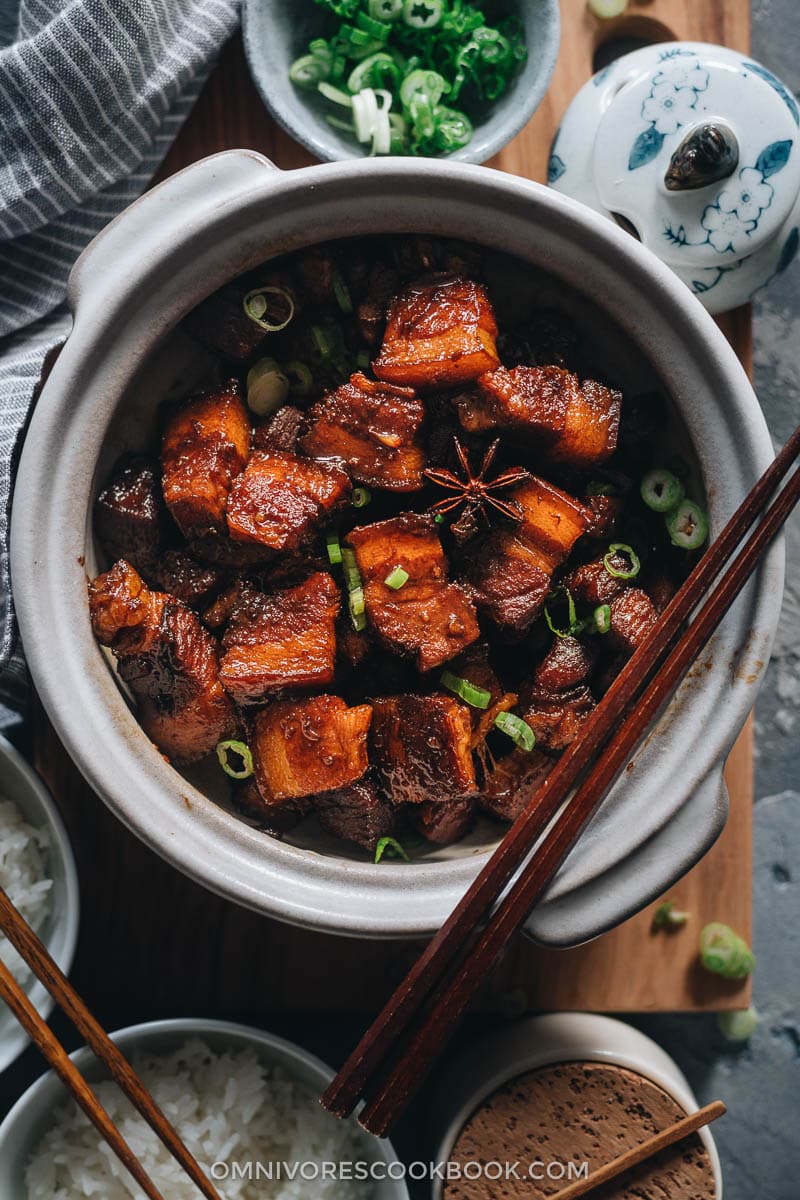
Hong Shao Rou (红烧肉), or red braised pork, is a beloved dish in China. Depending on the region, there are many different approaches to cooking it. Some versions taste sweeter, some taste more savory, while others taste spicy. However, all of them use the red braise cooking method to give the pork a glossy caramelized char. The pork is then simmered in liquid with Shaoxing wine, soy sauce, and plenty of aromatics until melt-in-your-mouth tender.
In the past I shared how my family braises pork. For example, the Northern Chinese style Braised Pork Ribs and Braised Pork Feet. The Hong Shao Rou recipe I’m sharing today is closer to Shanghai style, which is the more popular version in the US.
I can’t wait to show you how easy it is to cook this dish in your own kitchen!
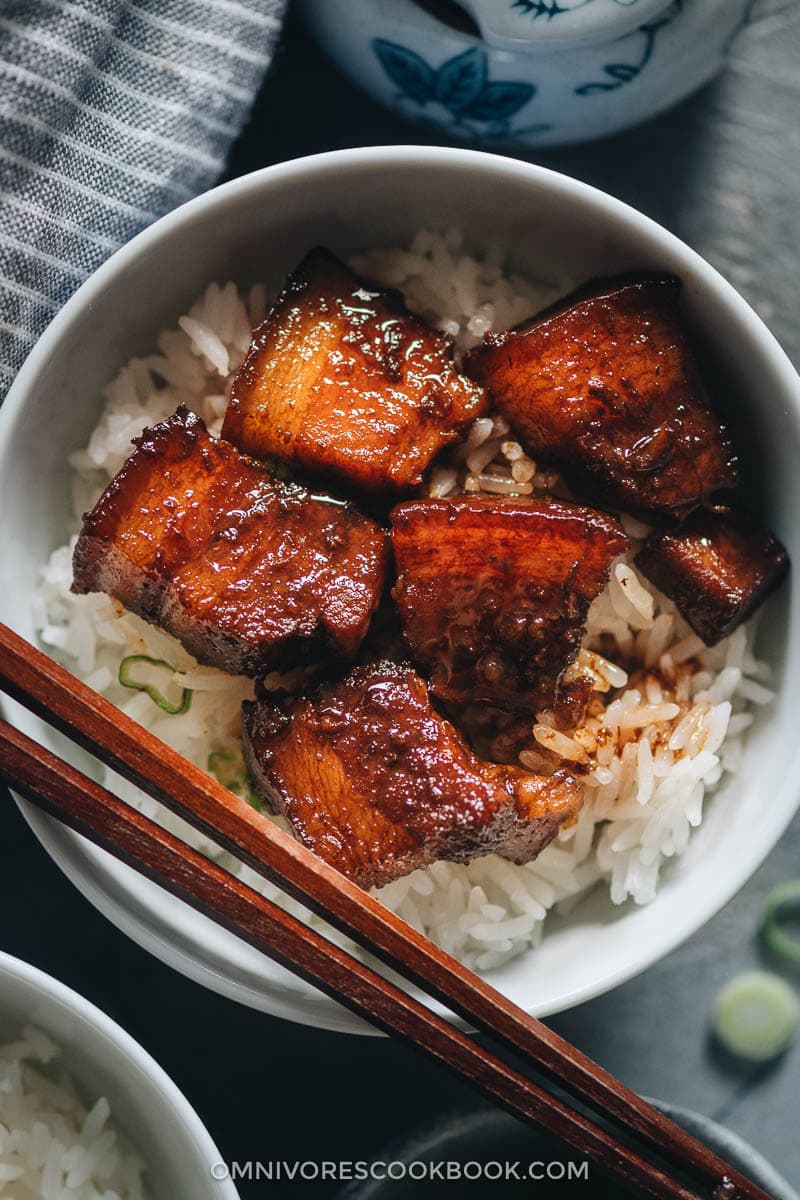
Hong shao rou ingredients
How to purchase pork belly
The authentic red braised pork always uses skin-on pork belly. You can usually find it in a Chinese market. I’ve even seen gorgeous cuts of pork belly at Costco. Personally, I always pick the leanest cut I can find, so the final version is less greasy. If you don’t like pork skin, the skinless type also works well. Most Korean and Japanese markets sell skinless pork belly. Some US grocery stores sell the cut too, but it tends to be very fatty at those places.
How to cut pork belly
Pork belly shrinks quite a bit during cooking. I prefer to cut it into 1” (2.5 cm) chunks, so it will absorb flavor well while holding its shape. Note, depending on the cut you get, the best shape to cut it into might be a rectangle (see the picture below). I got this sliced pork belly in Chinatown. I would cut them into long rectangles instead of further cutting them into squares. It’s important to leave the lean meat attached to the fat, so the meat will become extra tender from the braising.
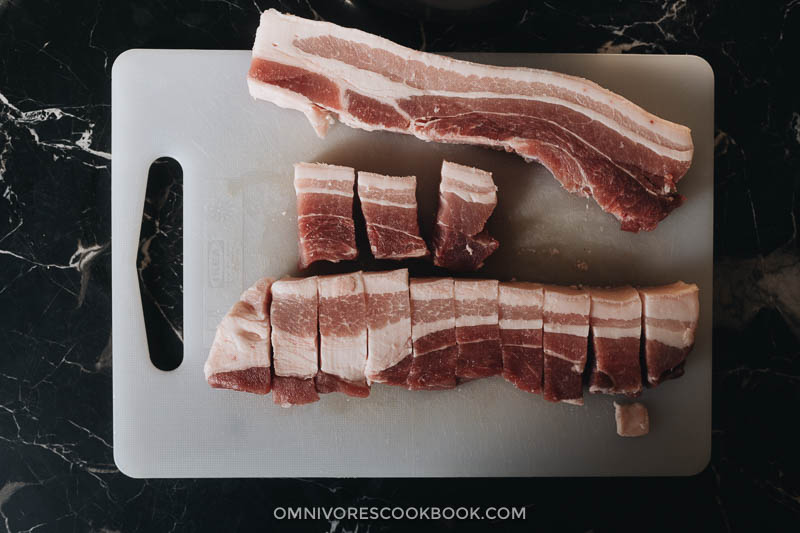
Hong shao rou braising ingredients
It doesn’t take many ingredients to make hong shao rou. You will need:
- Green onion
- Ginger
- Shaoxing wine
- Light and dark soy sauce
- Sugar
- Star anise
How to cook hong shao rou
1. Blanching the pork
This step is very important in most Chinese braised pork dishes. It gets rid of the impurities from the pork and imparts the meat with aromatics. The cooking liquid is reserved and used at the braising.
All you need to do is:
- Cover the pork with water and cook it with the aromatics
- Skim the foam from the surface
- Rinse the pork with cold tap water to further remove the impurities
- Drain and dry the pork thoroughly with paper towels (very important – it will prevent splatter when you cook the pork in the hot sugar)
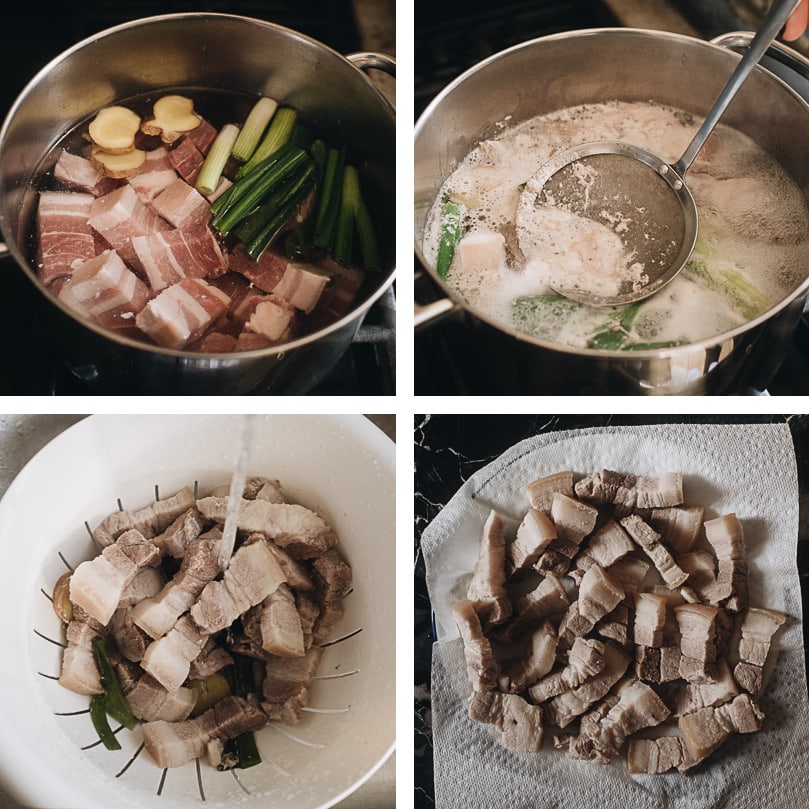
2. Sear the pork in sugar (炒糖色)
It’s a technique used in many red braised dishes. By melting sugar in oil, then cooking the pork in the syrup that results, the pork will be browned immediately with a beautiful caramel color. It will add depth of flavor and give the pork that shiny look at the end of the cooking.
While the method might sound daunting, it’s actually quite easy. All you need to do is to ensure that you dry the pork thoroughly and use a pot without any water on it. So it won’t cause any splatter.
- Sprinkle the sugar in the pan and add the oil
- Cook until the sugar melts and the color is amber
- Brown the pork in the melted sugar
- You might need to brown the pork in two batches depending on the size of the pan
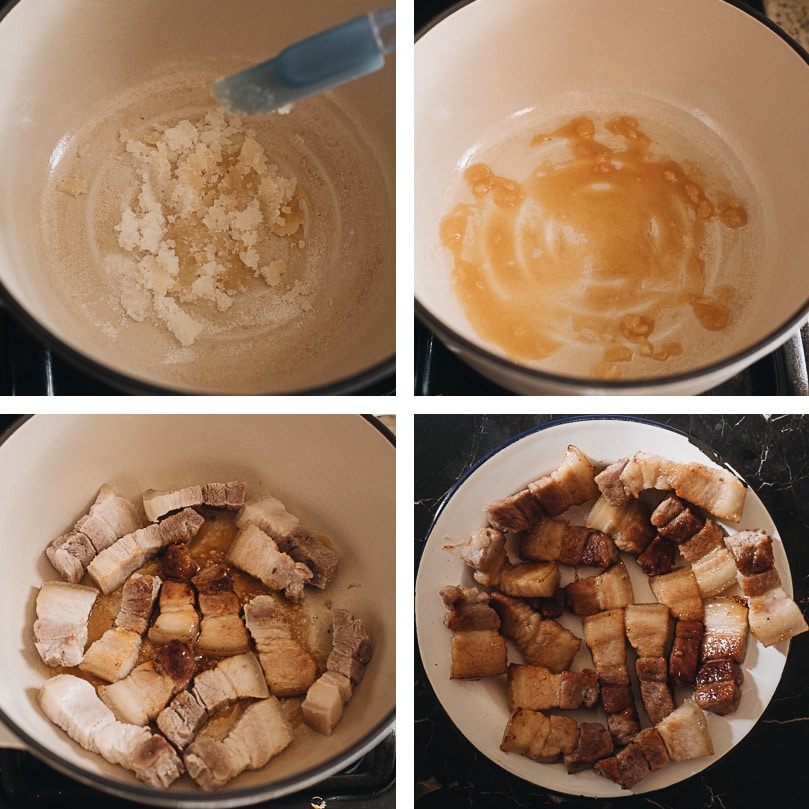
3. Braising
The easiest part!
- Add the browned pork, the braising liquid, and the aromatics.
- Braise until the broth is reduced to a thick glossy sauce and the pork is tender.
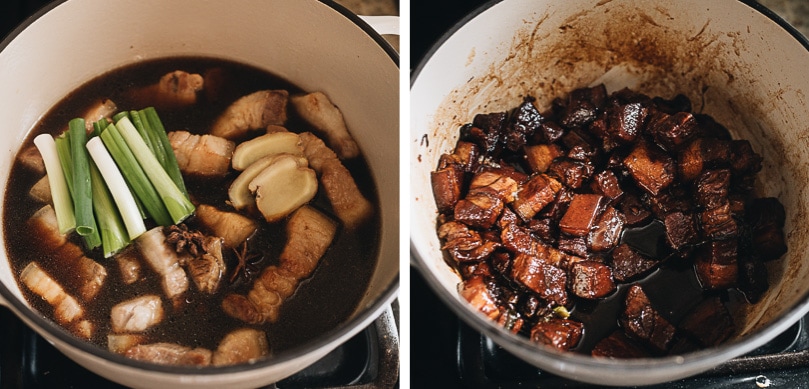
Side dishes to serve with hong shao rou
Hong Shao Rou is a very rich dish. Consider pairing it with steamed rice and leafy vegetables to create a balanced meal. Some side dishes that go well with it include:
- 4-Ingredient Baby Bok Choy Stir Fry
- Chinese Pickled Cabbage (A Quick Pickle Recipe)
- Easy Chinese Cucumber Salad
- Chinese Seaweed Salad
- Stir-Fried Pea Shoots with Garlic
This red braised pork also holds up very well and is freezer-friendly. Make it ahead and portion it out, so you can have delicious feasts throughout the busy week!
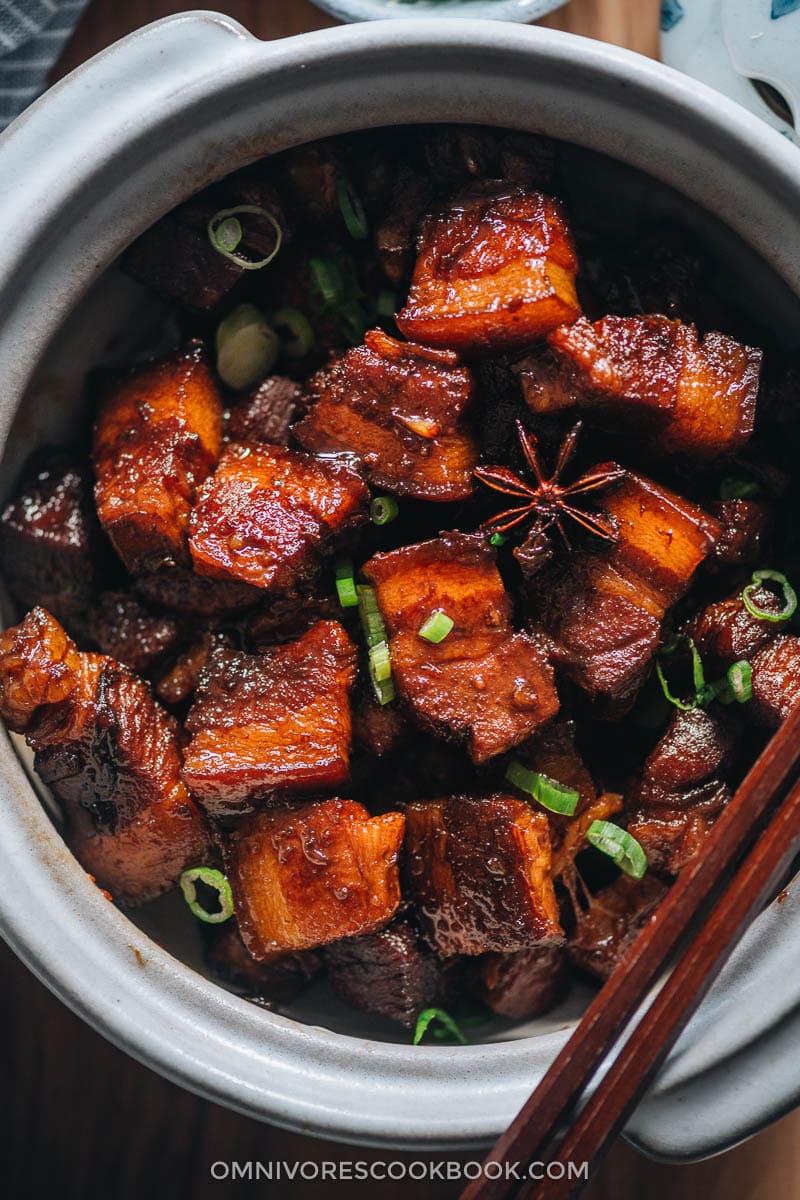
More delicious make-ahead recipes
- Chinese Chili (Sichuan Style)
- Char Siu (Chinese BBQ Pork)
- African Chicken (Macanese One-Pan Chicken Curry)
- Chinese Beef Stew with Potatoes
- Mom’s Best Braised Pork Ribs
If you give this recipe a try, let us know! Leave a comment, rate it (once you’ve tried it), and take a picture and tag it @omnivorescookbook on Instagram! I’d love to see what you come up with.
Chinese Cooking Made Easy
Are you new to this website? This free email series is a great place to start. I’ll walk you through a few of my most popular recipes and show you how and why they work. You’ll quickly start to cook better Chinese food in your own kitchen.
Watch video
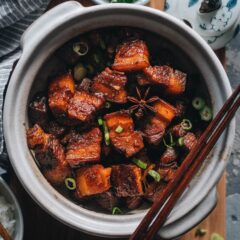
Hong Shao Rou (Red Braised Pork, 红烧肉)
Ingredients
- 1.5 to 2 lbs pork belly , cut into 1” (2.5 cm) cubes
Blanching Liquid
- 2 green onions , cut into 2” (5 cm) pieces
- 1/2" ginger , sliced
Braising Liquid
- 2 tablespoons peanut oil (or vegetable oil)
- 3 tablespoons sugar
- 1/3 cup Shaoxing wine (or dry sherry)
- 2 cups reserved blanching liquid
- 3 tablespoons light soy sauce (or soy sauce)
- 1 1/2 tablespoons dark soy sauce
- 1" ginger , sliced
- 3 green onions , cut into 2” (5 cm) pieces
- 2 whole star anise pods
Instructions
- In a medium-sized pot add the pork belly and enough water to cover it completely. Make sure there is some space between the water level and the lip of the pot to avoid boiling over and to make skimming easier.
- Add the green onions and ginger. Cook over high heat until the water reaches a full boil. Boil for 5 minutes, using a fine mesh strainer (or a ladle) to skim and discard the brown foam from the top, until the liquid is clear.
- Strain the pork and reserve the blanching liquid. Rinse the pork with running tap water to stop the cooking and rinse away any scum that may have stuck to it.
- In a separate medium-sized dutch oven or pot (make sure it is completely dry to avoid the oil and sugar splattering), add the sugar and oil. Heat over low heat until the sugar is melted and begins to brown; look for an amber color. Try to avoid stirring the sugar while melting it. Instead, swirl the whole pot.
- Once the caramel is a light amber color, carefully add the pork chunks by gently placing them into the caramel to minimize splashing or splattering. Depending on the size of your pot, you might need to add the pork in two batches.
- Turn the heat up to medium-low and brown the pork in the caramel, about 1 minute on each side. Be careful not to burn the sugar.
- Add the cooking wine and scrape with a wooden spatula to release any brown bits from the bottom of the pan. Add the reserved blanching liquid, light soy sauce, dark soy sauce, ginger, green onions, and star anise.
- Turn to medium-high heat until the broth comes to a boil. Turn to medium-low or low heat so the broth reduces to a simmer. Cover the pot, leaving a finger-width gap to allow the steam to escape. Simmer for 1 hour and 30 minutes. Stir 2 to 3 times during the simmering.
- If the pork has turned tender but the sauce isn’t fully reduced, remove the lid and bring the heat up to medium. Cook for another 10 or 15 minutes, until the liquid is reduced to a glaze consistency. Keep an eye on the pot during the process and stir to prevent burning on the bottom.
- Serve the pork with the glaze over steamed rice as a main course.
- You can store the leftovers in a sealed container in the fridge for 4 to 5 days or in the freezer for a month. To reheat the frozen pork, thaw it in the fridge overnight, then steam it until fully heated through, 15 to 20 minutes. If you want to reheat the pork in the microwave, cover the bowl with a plate to prevent oil splatter.
Nutrition

Did you make this recipe?
I’d love to hear how it turned out for you! Please take a moment to leave a 5-star rating ⭐️ and share your thoughts in the comments further down the page. It really helps others discover the recipe too.
Lilja Walter is a part of the Omnivore’s Cookbook team and worked closely with Maggie to develop and test this recipe.

Annemarie
Thank you for this recipe! I love Hon Shao Rou with the aromatic flavours of the Ginger and Star Anise and green onion. Your instructions are very easy and make this such a treat to make, and even better to taste!
It’s delicious!
cm
This is my go-to special occasion recipe. I’ve made it 10+ times in the last several years. it’s the one perfect recipe i don’t mess with. blanching the pork is the key step. Also be sure NOT TO STIR THE SUGAR as it caramelizes! Thanks for sharing Maggie!
DY Sanik
The website is broken. If you search anything, you get a half plate of “related” items and can never access the recipe you’re looking for. I had stopped using this website because of this, but came back because I thought it would be fixed. No, so, unfollowing.